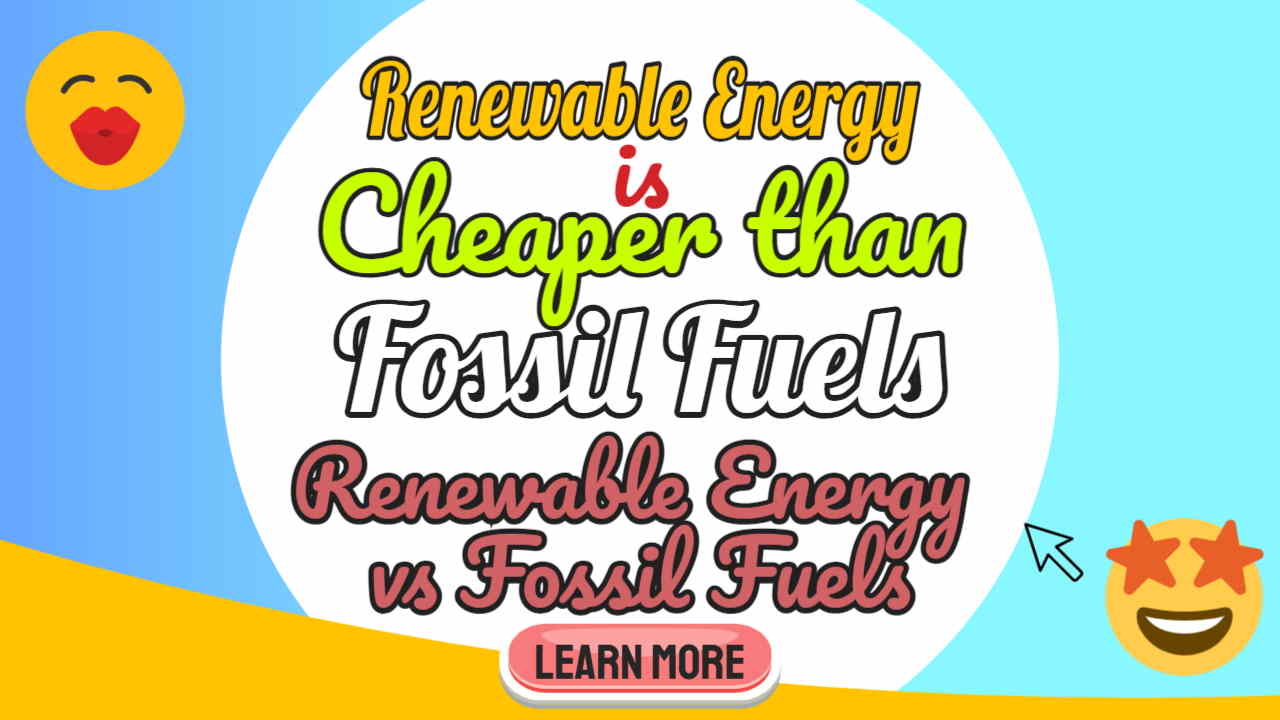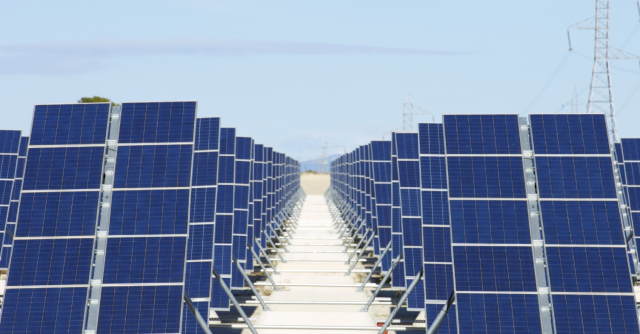As the global community grapples with the profound challenges posed by climate change, the focus on renewable energy sources has intensified since we first published our energy comparison article in mid-2020. No longer is it controversial to declare renewable energy cheaper than fossil fuels. Price rises on fuels, led by natural gas prices, jumped to almost triple the 2020 price during 2022, so very few if any people now question that statement.
One of the compelling arguments for shifting to renewable energy is not only the environmental implications but also the economic ones.
However, is renewable energy actually cheaper than traditional fossil fuels like coal, oil, and gas? Aren't there other factors such as the cost of storage of intermittent energy sources?
Read on to find out!
Renewable Energy vs Fossil Fuels – Cost Comparison
As of 2021, the economic case for renewable energy became increasingly compelling. The cost of solar and wind power, the two primary forms of renewable energy, has dramatically fallen over the past decade.
Solar power, for instance, has seen a remarkable reduction in costs. The average cost of solar photovoltaic (PV) modules (per watt) fell by over 89% between 2010 and 2020, according to the International Renewable Energy Agency (IRENA). Similar trends can be observed with wind energy, where costs decreased by nearly 70% over the same period.
In terms of direct cost comparison, several studies have found that renewable energy is often cheaper than coal, oil, and gas. For instance, Lazard's Levelized Cost of Energy Analysis – Version 14.0, one of the most widely recognized studies comparing the cost of different energy sources, found that as of 2020, the mean levelized cost of utility-scale solar was $31/MWh, while that of onshore wind was $26/MWh.
By contrast, the average cost of energy from coal was $65/MWh, and gas combined-cycle was $41/MWh.
Thus, on average, utility-scale solar and wind were cheaper than coal by approximately 52% and 60% respectively, and cheaper than gas by 24% and 37% respectively.

Some Circumstances May Still Occur When Renewable Fuels are More Expensive
However, to say that renewable energy is unambiguously cheaper than fossil fuels would be an oversimplification. There are several factors to consider.
Firstly, these costs are averages, and real-world prices can vary widely depending on geography, local policies, infrastructure, and resource availability.
For example, while solar and wind might be incredibly cheap in sunny or windy areas, they might not be as cost-effective in areas with less favorable weather conditions.
Secondly, the cost of energy storage, which is crucial for managing the intermittency of solar and wind power, is often left out of these comparisons. Although the cost of energy storage has been declining, it can still significantly increase the overall cost of renewable energy, especially for off-grid applications.
Lastly, the costs associated with transitioning from fossil fuels to renewables — like infrastructure upgrades, grid modernization, and potential job losses in fossil fuel industries — can be substantial and are often not factored into simple cost comparisons.
Biogas energy from biomethane is renewable energy and has also been found to be cheaper than natural gas, as we reported here, and it is a non-renewable alternative to natural gas.
Concluding – Renewable Energy vs Fossil Fuels: A Cost Comparison
To conclude, while it's true that the costs of generating electricity from solar and wind have fallen dramatically and are often cheaper than coal, oil, and gas on a per-unit basis, it's important to consider the broader picture.
The costs associated with storage and the transition to renewables can add to the overall cost of renewable energy.
Despite these additional costs, the continued decline in renewable energy costs, combined with their environmental benefits, strongly argues for their increased adoption in our energy mix. The future of energy, it appears, will be increasingly renewable.
The following is our original post, as posted on 14 June 2020. It is still worth reading today, only more so! The period 2022-23 saw a doubling of global natural gas prices, and electricity and other fuel prices also rose under pressure from shortfalls during Putin's War in Ukraine. While prices have since fallen back on the energy markets consumers in the UK have failed to see any significant fall in their bills as of May 2023.
Renewable
Renewable Energy Cheaper than Fossil Fuels – Especially Coal if Made by Solar or Wind
Energy is cheaper than Fossil Fuels now more often than not. That's a fact confirmed in a new IRENA Annual Report. This leads to the further question; “Is coal cheaper than renewable energy”? Not any longer!. Renewable energy has come down in cost and is now generally the cheapest, especially so for new installations.
But renewable energy is only cheaper if you are talking about Solar and Wind Energy. Solar and Wind technology has reached close to maturity. And, solar energy has made particularly huge strides in the last couple of years and has reduced massively in price. Wind energy from wind farm turbines has also dropped in price but not so dramatically. See below – scroll down for the comparison chart information.

Renewable energy is here to stay, but biogas and biomethane can't hope to compete with solar and wind energy on price per unit of energy produced. Anaerobic digestion and biogas technology have not yet reached the scale and level of investment seen by wind and solar.
Biogas and biomethane have many benefits, but to compete on price with wind and solar energy is not one of them.
Read on to find out exactly how renewable energy is on average now cheaper than coal.
This also means that there will from now on be no economic justification for building new power stations. This will also give a massive boost to solar and wind energy! (It will also help the world achieve Net-Zero 2050, as pledged by the nations of the world at the Paris 2015 Global Accord.)
Renewables Increasingly Beat Even Cheapest Coal Competitors on Cost
02 June 2020| Press Release:
Competitive power generation costs make an investment in renewables highly attractive as countries target economic recovery from COVID-19, a new IRENA report finds.
Abu Dhabi, United Arab Emirates, 2 June 2020 — Renewable power is increasingly cheaper than any new electricity capacity based on fossil fuels, a new report by the International Renewable Energy Agency (IRENA) published today finds. Renewable Power Generation Costs in 2019 show that more than half of the renewable capacity added in 2019 achieved lower power costs than the cheapest new coal plants.

Renewable Energy Cheaper than Fossil Fuels More Often than Not
The report highlights that new renewable power generation projects now increasingly undercut existing coal-fired plants. On average, new solar photovoltaic (PV) and onshore wind power cost less than keeping many existing coal plants in operation, and auction results show this trend accelerating – reinforcing the case to phase out coal entirely. Next year, up to 1 200 gigawatts (GW) of existing coal capacity could cost more to operate than the cost of new utility-scale solar PV, the report shows.
Replacing the costliest 500 GW of coal with solar PV and onshore wind next year would cut power system costs by up to USD 23 billion every year and reduce annual emissions by around 1.8 gigatons (Gt) of carbon dioxide (CO2), equivalent to 5% of total global CO² emissions in 2019. It would also yield an investment stimulus of USD 940 billion, which is equal to around 1% of global GDP.
“We have reached an important turning point in the energy transition. The case for new and much of the existing coal power generation, is both environmentally and economically unjustifiable,” said Francesco La Camera, Director-General of IRENA. “Renewable energy is increasingly the cheapest source of new electricity, offering tremendous potential to stimulate the global economy and get people back to work. Renewable investments are stable, cost-effective, and attractive offering consistent and predictable returns while delivering benefits to the wider economy.
“A global recovery strategy must be a green strategy,” La Camera added. “Renewables offer a way to align short-term policy action with medium and long-term energy and climate goals. Renewables must be the backbone of national efforts to restart economies in the wake of the COVID-19 outbreak. With the right policies in place, falling renewable power costs, can shift markets and contribute greatly towards a green recovery.”
Renewable Energy Costs for wind and Solar Have Taken Another Tumble, Making Fossil Fuels Look More Expensive Than Ever
Renewable electricity costs have fallen sharply over the past decade, driven by improving technologies, economies of scale, increasingly competitive supply chains, and growing developer experience. Since 2010, utility-scale solar PV power has shown the sharpest cost decline at 82%, followed by concentrating solar power (CSP) at 47%, onshore wind at 39%, and offshore wind at 29%.
Costs for solar and wind power technologies also continued to fall year-on-year. Electricity costs from utility-scale solar PV fell 13% in 2019, reaching a global average of 6.8 cents (USD 0.068) per kilowatt-hour (kWh). Onshore and offshore wind both declined by about 9%, reaching USD 0.053/kWh and USD 0.115/kWh, respectively.

Recent auctions and power purchase agreements (PPAs) show the downward trend continuing for new projects commissioned in 2020 and beyond. Solar PV prices based on competitive procurement could average USD 0.039/kWh for projects commissioned in 2021, down 42% compared to 2019 and more than one-fifth less than the cheapest fossil-fuel competitor namely coal-fired plants. Record-low auction prices for solar PV in Abu Dhabi and Dubai (UAE), Chile, Ethiopia, Mexico, Peru, and Saudi Arabia confirm that values as low as USD 0.03/kWh are already possible.
For the first time, IRENA’s annual report also looks at investment value in relation to falling generation costs. The same amount of money invested in renewable power today produces more new capacity than it would have a decade ago. In 2019, twice as much renewable power generation capacity was commissioned as in 2010 but required only 18% more investment.
Read the full report Renewable Power Generation Costs in 2019
[First posted June 2020.]






